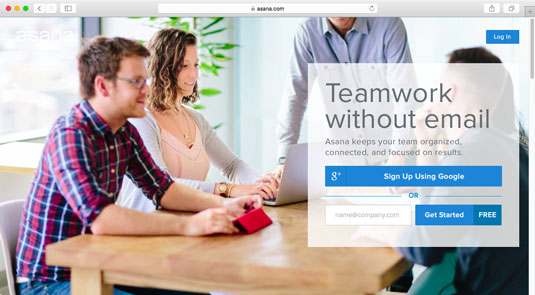
Source: asana.com
Since email has become a necessity in most everyone’s everyday life, adding a bunch of extra material to the mix only makes things more hectic and complicated. To have the capability to collaborate with co-workers, classmates, and other teams or groups more easily is the entire concept behind the creation of Asana.
Keep in mind that Asana is free to teams that have 15 or fewer members. Larger teams or enterprise situations require a software license that varies in price, depending on the number of members you want to include in your group.
How Asana can eliminate email
Since Moskovitz has laid claim to eliminating the need for email by using Asana, you may be asking yourself how this is even possible. The following list describes ways in which Asana can eliminate excess email or work-related email altogether.-
Attachments: Attachments allow you to escape the need for uploading files to an email server and sending them to the appropriate contacts. Instead, you will be able to add attachments to a specific project, and all people included in the project will be able to access and edit the attachments as needed.
-
Discussions: Discussions allow teams to contact each other with questions and answers without the need for long email threads. Allowing discussions that can be attached to specific projects enables you to find a specific response more quickly and with ease. No more digging through long email threads to find the information you need ASAP!
-
Projects: Projects allow you to organize and distribute content within your team. Here you will be able to “clump” together pertinent information so that all team members are on the same page with what work needs to be done. You will be able to access and follow attachments, discussions, statuses, and tasks that are related to the specific project you have been assigned.
-
Statuses: Statuses allow all team members to see the status of a project and who is currently at the helm. Knowing who is working on any given project at any given time allows you to contact the correct person or people responsible without sending out bulk or mass emails to the entire organization.
-
Tasks: Tasks allow you to break down your work into individual pieces. When completing a task you would check it off your list, the list is then updated within the team’s page, and everyone onboard will know the task has been completed. No more confusion and extra emails asking if you had completed the task yet or not.
The only way Asana can truly eliminate the need for team or work email is if every team member uses the Asana web or mobile application regularly.
Why use Asana?
Since Asana is a task-management application developed for a more effective use of collaboration within an organization, many types of organizations may find this application quite useful.For example, in the freelance writing industry there is an author, editor, and publisher.
-
The publisher would contact the author and editor regarding new work that needs done. (2 emails)
-
The author then would contact the publisher and his or her editor regarding whether or not she wants to take the work. (2 emails)
-
If the author takes the work, the assignment is then sent to the editor in the form of a second draft. (1 email)
-
The editor then sends the draft back to the author to “OK” the revisions. (1 email)
-
The author looks over the edited work and makes any changes as needed and sends back a third draft to her editor. (1 email)
-
The editor then approves the changes and makes any final corrections before submitting the final work to the publisher. (1–2 emails)
-
If the publisher approves of the work done, then the author is contacted regarding payment of work completed. (1 email)
In this particular case, if the authors, editors, and publisher were to connect as a team on Asana, the need for email would be eliminated completely.
-
The publisher would post new assignments in the form of a project on the Asana app, and the authors and editors then can take on or follow the status of each project.
-
When the author takes on a project she can create a list of tasks within the project and upload related attachments.
-
The editor then accesses the uploaded content, provides feedback, and make changes right within the Asana application.
-
The author provideher feedback to what changes the editor made.
-
All while this collaboration is taking place between the author and editor, the publisher is able to follow along and provide any additional support as needed; completing the project without sending a single email.
Asana is also useful to other collaborative team situations such as software development teams, teacher and student groups, government offices, as well as many others.
If you do any type of collaboration within a team or group and its members total less than 15 people, then sign up and give Asana a try; it's free! If you are part of a much larger team or organization, try creating a small group first to see how Asana will work for you and your team. If you find it is a useful bit of web-based software, then see whether your company or organization is willing to pay for a version that allows more team members.

